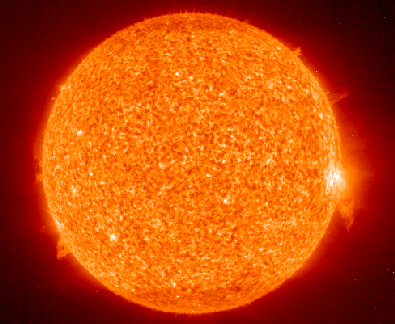Astronomy Picture of the Day
Discover the cosmos!
Each day a different image or photograph of our fascinating universe is
featured, along with a brief explanation written by a professional
astronomer.
May 20, 1996

Helios Helium
Credit:
EIT Consortium,
SOHO project,
ESA,
NASA
Explanation:
Above is an image of the relatively quiet Sun
made on May 18 in light emitted
by ionized
Helium atoms in
the Solar chromosphere.
Helium was first discovered in
the Sun in 1868,
its name fittingly derived from from the Greek word Helios, meaning
Sun. Credit for the discovery goes to astronomer Joseph Lockyer.
Lockyer relied on a recently developed
technique of spectroscopy,
dissecting sunlight into a spectrum,
and the idea that each element produces a characteristic spectral pattern
of bright lines.
He noticed a yellow line in a solar spectrum made during an eclipse
which could not be accounted for by elements known on Earth. Almost 27
years later
Helium was finally discovered on Earth when the
spectrum of a
Helium bearing mineral of Uranium
provided an exact match to the
previously detected element of
the Sun. Helium is now known to be
the second most abundant element (after Hydrogen) in the Universe.
Tomorrow's picture: The Iron Sun
| Archive
| Index
| Search
| Glossary
| Education
| About APOD |




Authors & editors:
Robert Nemiroff
(GMU) &
Jerry
Bonnell (USRA).
NASA Technical Rep.:
Sherri
Calvo.
Specific rights apply.
A service of:
LHEA
at
NASA/
GSFC




